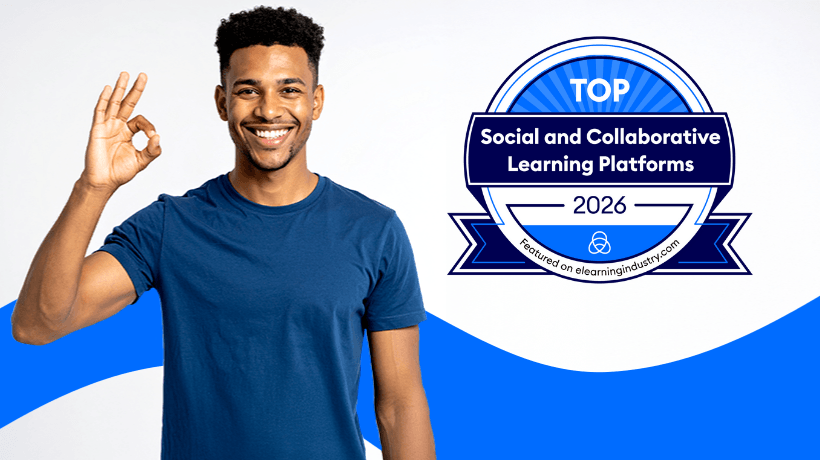Enhance Virtual Learning With Social Learning
A virtual learning environment is a medium of learning where learners go through courses, study materials and learning aids through an online medium. It can be browser-based or a virtual training session through Zoom. Virtual learning offers activities, interactions, and resources within a course structure and provides different levels of assessment. Given this context, learners can access learning materials through peer-to-peer collaboration networks such as forums. As social learning is a continuous process of learning from other people within and outside the organization, it can be integrated into virtual learning through various means.
At the present virtual learning also happens through social technologies like blogs, wikis, discussion forums, messaging tools, conferencing tools, subject-matter directories, and videos. Organizations are increasingly using social learning in their training methodologies for improved learning retention, increased learner engagement, and reduced training costs.
The 70:20:10 Learning Framework
In traditional classroom training, most learners recall only 10% of what they have learned after 72 hours. Such lack of knowledge retention can harm the business of your organization. For example, a salesperson may face trouble recalling the knowledge learned at the appropriate time the next week, which could cost them a sale.
As per this methodology, about 70% of learning happens through on-the-job training and practical experiences, 20% through interaction with peers and colleagues, and just 10% in a traditional, instructor-led classroom training environment.
Why Social Learning?
Social learning helps employees with enhanced retention of knowledge, which is the primary goal of any training program. Social learning encourages learning in a working environment and allows learners to apply their knowledge to work. They can learn from peers, senior employees, or experts within the organizations. People learn from real-life scenarios/examples and by direct experiences. Research studies also indicate that social learning methods deliver a better ROI (almost 75:1 ratio) when compared to traditional classroom training.
Here are a few strategies on how to enhance virtual learning with the help of social learning.
Enhance Learner Engagement
A virtual learning environment allows you to manage the learning activities by using various means such as an LMS for learner administrations, learning platforms, and virtual instructor sessions. In social learning, employees can either start or take part in a discussion, training or coach others as and when a situation arises. This type of freedom to engage in their learning will directly impact increased engagement in their work.
As part of social learning, provide a network of mentors and peers, where information is created and distributed easily to employees. Thus, employees can obtain more practical knowledge and make better decisions through increased engagement with others.
Collaborate Proactively With Learners
Communication and collaboration among the participants with emails, chat, wikis, blogs, etc., are other key components of a virtual learning environment. Social learning is collaborative in its approach, happens in real-time, and has a direct relation to an employee’s work. Learning can happen anytime, anywhere, and by using any device. Organizations that support social learning need to have learning environments that foster conversation, discussion, and collaboration between learners across the organization.
Social learning involves knowledge sharing in a joint effort between peers, and between peers and facilitators. It promotes high-level thinking, good relationships, oral and written communication, self-management, responsibility, and leadership skills.
Encourage Peer Learning
Peer learning is a great way in which learners learn from each other. Participants connected can observe and learn from others, helping each other in the virtual session. Learners can directly learn from seniors and experts who have been in similar situations. In peer learning, learners receive more time for individualized learning, and interactions between employees promote active learning.
Learners get a chance to reinforce their learning by instructing others. Also, learners feel more comfortable and open when interacting with their peers. For companies, peer learning is a financially efficient alternative to hiring trainers or instructors. Research studies indicate that peer learning activities yield more benefits to the organization, such as enhanced team-building spirit, more supportive relationships, greater psychological well-being, and improved communication skills. Thus, organizations should encourage peer learning to achieve greater productivity.
Add Simulations And Gamification Elements
Simulations and gamification help facilitators turn their virtual learning into a more interactive experience. Simulations can turn virtual learning sessions into more interesting and fun learning sessions. Mock trials and digital simulations are great ways to enhance a virtual learning session and engage the participants more.
Gamification involves turning an activity into a competitive game for the learners. You can take learning concepts, assignments, and activities and convert them into interesting games. The facilitator can announce badges and rewards for winners and create that unique spark that attracts the learners' interest. Gamification and simulations allow learners to observe real-life scenarios and examples.
Conclusion
The social learning strategies discussed in this article will help you improve learner participation and conduct successful virtual learning sessions in your organization. Social learning allows for better interaction between various learners. It is a great way to enhance your virtual learning experiences and take learning to the next level.
At Tesseract Learning, our learning and visual architects are constantly innovating and reinventing their approaches to design, develop, and deliver effective L&D programs.
I hope you find this article insightful and that it helps you enhance your virtual learning sessions. If you have any specific queries, do contact me or leave a comment below.










